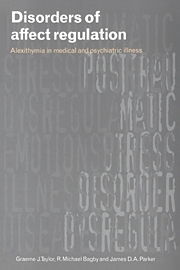Book contents
- Frontmatter
- Contents
- Foreword
- Acknowledgments
- Acknowledgment of permission for use of material
- Introduction
- 1 The development and regulation of affects
- 2 Affect dysregulation and alexithymia
- 3 Measurement and validation of the alexithymia construct
- 4 Relations between alexithymia, personality, and affects
- 5 The neurobiology of emotion, affect regulation, and alexithymia
- 6 Somatoform disorders
- 7 Anxiety and depressive disorders and a note on personality disorders
- 8 Substance use disorders
- 9 Eating disorders
- 10 Affects and alexithymia in medical illness and disease
- 11 Treatment considerations
- 12 Future directions
- Appendix
- References
- Index
1 - The development and regulation of affects
Published online by Cambridge University Press: 21 September 2009
- Frontmatter
- Contents
- Foreword
- Acknowledgments
- Acknowledgment of permission for use of material
- Introduction
- 1 The development and regulation of affects
- 2 Affect dysregulation and alexithymia
- 3 Measurement and validation of the alexithymia construct
- 4 Relations between alexithymia, personality, and affects
- 5 The neurobiology of emotion, affect regulation, and alexithymia
- 6 Somatoform disorders
- 7 Anxiety and depressive disorders and a note on personality disorders
- 8 Substance use disorders
- 9 Eating disorders
- 10 Affects and alexithymia in medical illness and disease
- 11 Treatment considerations
- 12 Future directions
- Appendix
- References
- Index
Summary
Although affects have long been considered a basic and essential feature of human experience, there has never been any clear agreement on a definition and theory of affects; and only recently have psychologists and psychiatrists shown a serious interest in how affects develop and come to be regulated. Some psychologists distinguish between emotions and affects, but their definitions of these constructs are inconsistent; others use these terms synonymously but distinguish them from the word feelings. In this chapter, we will review contemporary theories and recent research on affect development and affect regulation. First, however, we will summarize several major theories and conceptualizations of emotion, and also discuss the relations between emotion and cognition and the role of affects in the organization of the personality.
Emotions, affects, and feelings
In the modern era, controversy about the definition of the construct of emotion has existed since the publication over 100 years ago of William James's now famous essay entitled ‘What is an emotion?’ While James (1884) and Lange (1885) believed that emotions result from the afferent feedback to the brain of different patterns of peripheral autonomic nervous system activity and other bodily states (i.e. emotions were construed as nothing but the awareness of different physiological changes in response to arousing stimuli – the ‘James–Lange theory’), Cannon (1927) argued that emotions arise from the subcortical regions of the brain and that the autonomic responses are merely an output component of the brain processes that define the experience of emotion (Porges, 1991).
- Type
- Chapter
- Information
- Disorders of Affect RegulationAlexithymia in Medical and Psychiatric Illness, pp. 7 - 25Publisher: Cambridge University PressPrint publication year: 1997
- 17
- Cited by



